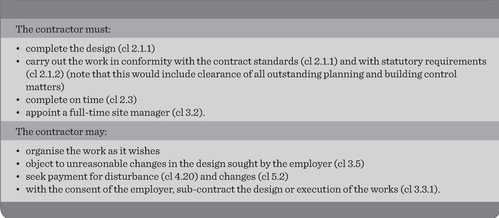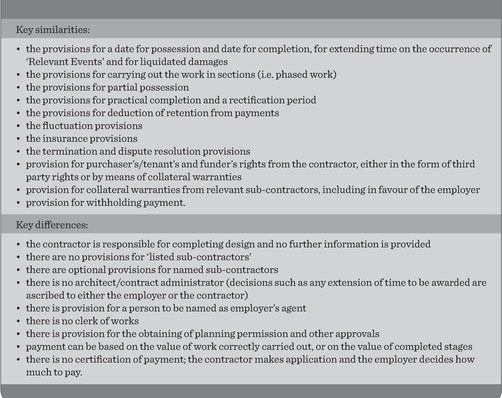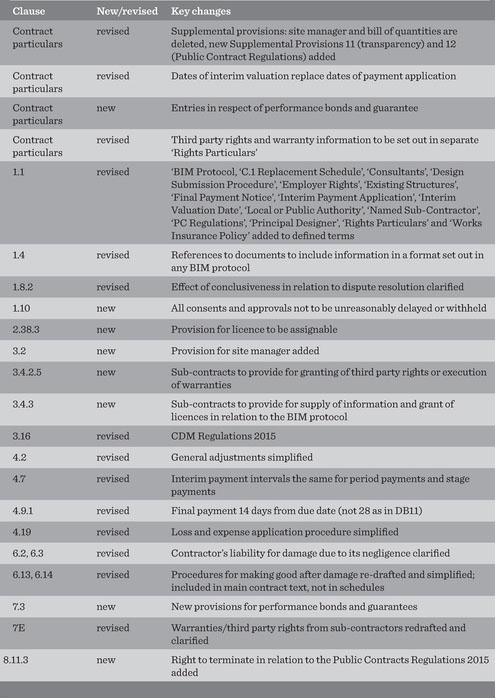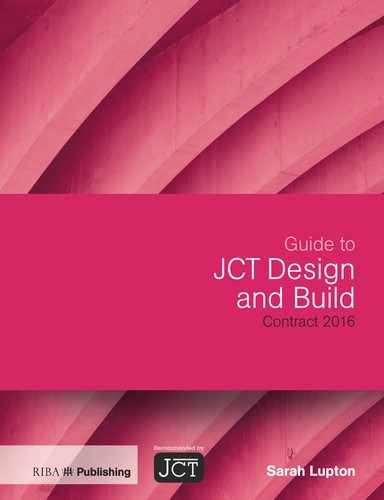2 About DB16
2.1 The JCT Design and Build Contract (DB16) is intended for use on building projects where ‘the Employer has defined his requirements and where the Contractor is not only to carry out the works, but also to complete the design for them in accordance with those requirements’ (DB/G). It is applicable where the employer has issued a document to the contractor at tender stage stating the employer’s requirements, and, in response, the contractor has submitted proposals for the design to the extent and detail required under the employer’s requirements.
2.2 The form is published in only one version, for use by both private clients and local authorities. The contract particulars indicate that certain provisions (e.g. cl 4.6, provisions for advance payment and an associated bond) do not apply where the employer is a local or public authority. Special provisions are included which are required by or essential to its use by local authorities and public bodies, as discussed below at paragraph 2.18.
2.3 The form follows the normal JCT format of agreement, recitals, articles, contract particulars, attestation and conditions. The sixth recital makes reference to a framework agreement which may supplement the provisions of the contract. The form also includes 12 ‘Supplemental Provisions’ under Schedule 2. These optional provisions are referred to in the seventh recital, and are incorporated by indicating whether or not they are to apply in the contract particulars (note that Part 1 of the Supplemental Provisions only applies if indicated, whereas Part 2 applies unless stated otherwise; supplemental provisions 11 and 12 apply only where the employer is a local or public authority, see footnote [9]). The operation of some of these provisions depends on the correct drawing up of the employer’s requirements.
2.4 The form contains an advance payment bond (Schedule 6: Part 1), a bond in respect of payment for off-site goods and materials (Schedule 6: Part 2) and a bond in lieu of retention (Schedule 6: Part 3). The JCT collateral warranties from the contractor to a funder (CWa/F) and purchaser or tenant (CWa/P&T), which are published separately, may be used with DB16, as may the JCT collateral warranties from a sub-contractor to a funder (SCWa/F), purchaser or tenant (SCWa/P&T) and employer (SCWa/E).
2.5 The JCT publishes a guide for use with DB16 (the Design and Build Contract Guide, DB/G). This gives general guidance on the scope of the clauses and the changes since DB11. JCT Practice Note CD/1A gave guidance on the employer’s requirements, the contractor’s proposals, the contract sum analysis, value added tax and insurance to cover the contractor’s design liability. CD/1B presented a commentary on the form, with notes on the contract sum analysis and the application of the formula adjustment for fluctuations. Despite the fact that the most recent editions of both practice notes were published as early as 1995, they still contain some very useful advice.
Key features
2.6 DB16 is a design and build ‘lump sum’ contract, under which the contractor is required to complete the design for, and to carry out the construction of, the work described briefly in the first recital and detailed in the contract documents, for the sum entered in Article 2, and to complete the work by the date entered in the contract particulars. It is important to note that the contractor is responsible for only that portion of the design which it actually completes, and not for the design as a whole.
2.7 The key differences between DB16 and traditional forms published by the JCT are, first, that the employer provides no further information to the contractor after the contract is entered into (the contractor has sole responsibility for completing the design) and, second, that no individual is appointed to exercise the functions of architect or contract administrator.
2.8 The contractor is responsible for constructing the works as described in the contract and for completing the design as necessary. The contract anticipates that the design could be at various stages of completion at tender stage. The second recital refers to documents termed the ‘Employer’s Requirements’ and ‘Contractor’s Proposals’, both of which form part of the contract documents. The requirements are sent out with the tender documents (and may contain an outline design) and the proposals are submitted with the tender.
2.9 The quality and quantity of work to be carried out is detailed in the employer’s requirements and the contractor’s proposals together with any further documents that the contractor prepares after appointment. The contractor is responsible for completing the design to meet the requirements, and for ensuring that it complies with statutory requirements. There is a requirement to submit the developing design proposals to the employer (cl 2.8 and Schedule 1).
2.10 The contractor’s level of design liability is limited to that of a professional person (cl 2.17.1), therefore there is no strict duty to provide a building that meets the requirements set out in the employer’s requirements, only to use due skill and care in preparing the design. If a higher level of liability is required, the employer may wish to consider amending this clause, although increasing the level of liability may result in higher tender prices.
2.11 The contract states what is to happen if there are discrepancies in either the requirements or the proposals. However, it does not expressly deal with a conflict between the two, i.e. if the proposals do not match the requirements. Although the employer is stated to be satisfied that the contractor’s proposals appear to meet its requirements (third recital), it is likely that the requirements would take precedence (see paragraphs 3.39 and 3.40).
2.12 As no individual exercises the functions of the architect or contract administrator under DB16, the functions that might be ascribed to such a person under a traditional form are either omitted or modified, so that they can be undertaken either by the employer (which is the most usual situation) or the contractor.
2.13 The form provides for the employer to employ an agent to represent its interests, who could, of course, be an architect. The person named in the contract as agent will be ‘stepping into the shoes’ of the employer and will have authority to take the decisions and actions assigned to the employer under the contract. It should be noted that this is a very different role from that of contract administrator, as the agent is under no express obligation to act impartially, although it may be assumed that a duty of good faith will be implied.
2.14 The contractor tenders a lump sum and an analysis of that sum (the contract sum analysis). Payment to the contractor is made either at the end of agreed stages or at monthly intervals, following application by the contractor. In general terms, the payment will reflect the amount of work that has been properly completed in accordance with the terms of the contract up to the point of payment, plus the amount of design work that has been carried out, based on the breakdown in the contract sum analysis. The contract sum is adjusted in accordance with the conditions; for example, the provisions relating to instructions, loss and/or expense and fluctuations and, where relevant, this adjustment is based on the contract sum analysis. There are optional provisions for the use of bills of quantities.
2.15 All the requirements of the Housing Grants, Construction and Regeneration Act (HGCRA) 1996 as amended by the Local Democracy, Economic Development and Construction Act (LDEDCA) 2009 regarding payment and notices are, of course, incorporated into DB16, and the provisions regarding listed items and advance payments, which were introduced into JCT80 alongside the HGCRA 1996 requirements, are also included in DB16. The more recent revisions (since 2011) are discussed below at paragraphs 2.22 and 2.23.
2.16 The contractor may sub-contract the work, including the design for the work, to domestic sub-contractors with the written approval of the employer. The JCT publishes standard forms of contract for use with domestic sub-contractors, and the contractor is required to sub-let on these terms where appropriate. There are no provisions for nominating a subcontractor but, under the Schedule 2 supplemental provisions, there are optional clauses allowing for a sub-contractor to be named. If these clauses are to be used, details must be included in the employer’s requirements and the contractor is required to use the JCT named sub-contract forms for tendering and for the sub-contract. The contractor remains fully responsible for the performance of domestic and named sub-contractors, including any design they undertake, except that, in the event of termination of the employment of a named sub-contractor, the employer shares some of the risk for the additional costs of completing the work (see Table 2.1).
Table 2.1 Key responsibilities of the parties

2.17 The form includes 12 optional supplemental provisions (Schedule 2), which allow it to be tailored to suit the parties’ requirements. These include the use of named sub-contractors, contractors’ estimates of the value of changes, acceleration and several provisions that reflect a partnering ethos, including collaborative working, cost savings and value improvements, and key performance indicators. It also allows for the use of a framework agreement, which might further enhance the partnering provisions, although such an agreement cannot override the provisions of the contract.
2.18 DB16 has many features required for public sector procurement, including ‘Fair Payment’ provisions, transparency and the use of BIM (building information modelling). These were originally published as a supplement to the JCT contracts, but have now been incorporated into the form with some further amendments. The Fair Payment provisions arise from the stated aims of the government in Construction 2025, which include equitable financial arrangements and certainty of payment throughout the supply chain. The aims are reflected in initiatives such as the Construction Supply Chain Payment Charter 2014, the HGCRA 1996 (as amended), the Late Payment of Commercial Debts Regulations 2013 and the Fair Payment Charter, as well as regulation 113 of the Public Contracts Regulations 2015. These require that the final date for payment should be ‘no later than the end of a period of 30 days from the date on which the relevant invoice is regarded as valid and undisputed’ (regulation 113(2)(a)), and that similar provisions are included in sub-contracts and sub-subcontracts. Under the charter, the value of work and materials supplied by all three tiers is to be assessed as at the same date. Adopting DB16 together with the appropriate JCT sub-contracts will ensure that the government requirements are met. The contract also includes provisions (Supplemental Provision 11) relevant to any employer that is subject to the Freedom of Information Act 2000 (which would include local authorities). This provides that the parties accept that the contract is not confidential, except for material that may be ‘exempt’ and which the employer has the discretion to determine. The Public Contracts Regulations 2015 also deal with corrupt practices and bribery, and breach of the statutory requirements is a ground for termination under clauses 8.6 and 8.11.3 of DB16. Furthermore, under Supplemental Provision 12 the contractor must include similar provisions in any sub-contract.
Deciding on DB16
2.19 DB16 is one of three JCT forms suitable if the contractor is undertaking a large part of the design. The two others, the Major Project Construction Contract and the Constructing Excellence Contract, are both intended for very large projects, and would normally require legal advice to prepare the tender and contract documents. For contracts where the contractor’s design responsibility is restricted to discrete parts of the works, use of SBC16, with its provisions for a contractor’s designed portion, should be considered. For smaller projects, where the contractor’s design input is limited, ICD16 or MWD16 may be appropriate.
2.20 Care should be taken where the client is a consumer, particularly where the project involves providing a dwelling that the client intends to occupy. The HGCRA 1996 does not apply in this situation, and some of the ICD provisions may be considered unfair under the Unfair Terms in Consumer Contracts Regulations 1999 (SI 1999/2083) if not individually negotiated with the client prior to entering into the contract. In such situations, and where some design input is required from the contractor, the RIBA Domestic Building Contract would be particularly suitable.
Comparison with SBC16
2.21 For those who are familiar with SBC16, much of the text of DB16 will look surprisingly similar, given the considerable difference between the two methods of procurement that they cover. These similarities result from the JCT’s sensible policy of adopting common wording wherever possible across forms. There are, of course, major differences between the forms. Some of the key similarities and differences between the forms are summarised in Table 2.2.
Table 2.2 Key comparisons between SBC16 and DB16

Changes in the 2016 edition
2.22 Prior to the 2016 edition, the JCT had published one set of adjustments to the 2011 edition: Amendment 1 (March 2015), relating to the CDM Regulations 2015. The JCT had also published a Public Sector Supplement for use by local or public authorities. These changes are now incorporated in the 2016 edition.
2.23 The key 2016 changes are set out in Table 2.3 and can be summarised as follows:
- incorporation and updating of provisions from the JCT Public Sector Supplement relating to Fair Payment principles, transparency and BIM;
Table 2.3 Key changes

- amendments relating to the CDM Regulations 2015;
- reference made to various provisions of the Public Contracts Regulations 2015;
- changes in respect of payment, designed to reflect Fair Payment principles and to simplify and consolidate the payment provisions;
- payment is monthly, whether using the ‘periodic’ or ‘stage payment’ option;
- removal of Fluctuations Options B and C – these are now published separately;
- the inclusion of performance bonds and parent company guarantees;
- tightening up of the arrangements to secure provision of third party rights/warranties from sub-contractors;
- simplification and rationalisation of drafting in many areas; for example, calculation of amounts due and provisions for rectification following damage covered by insurance.

